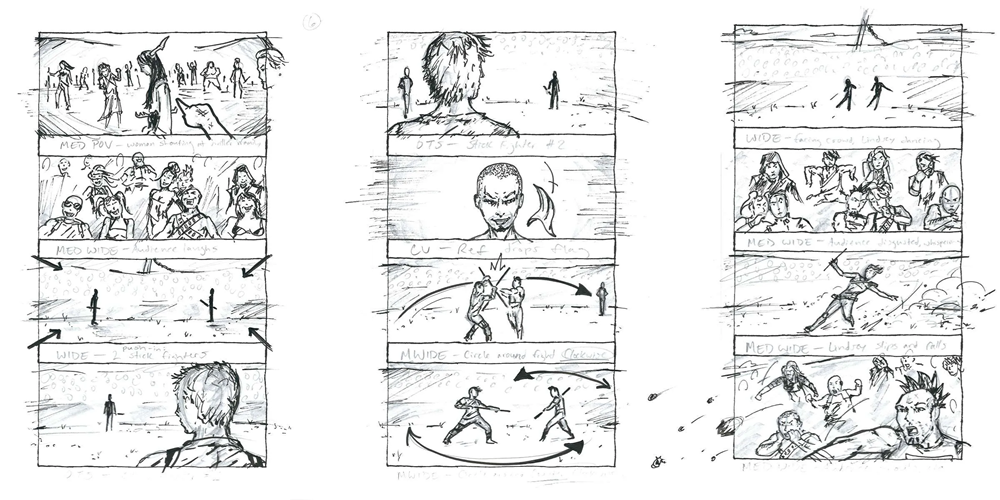How to Storyboard Action Scenes: Mastering Timing, Framing, and Flow
Illustrate Now
Creating action sequences that are exhilarating, dynamic, and visually coherent is a cornerstone of compelling storytelling in visual media. Whether you’re developing an animated short, a graphic novel, a cinematic sequence, or a game’s narrative, the ability to effectively storyboard action scenes is paramount to ensuring these moments land with maximum impact and clarity. This definitive guide, drawing on established industry principles and decades of collective practice in visual storytelling, will walk you through the core components of crafting dynamic action storyboards: timing, framing, and flow.
Let’s delve into the techniques that transform static panels into thrilling motion.
Table of Contents
ToggleThe Distinctive Nature of Action Scenes in Storyboarding
Action scenes fundamentally differ from dialogue-heavy or leisurely paced sequences. Their effectiveness hinges critically on the precise conveyance of movement, rhythm, and escalating visual tension. Every element, from the explosive speed of a punch to the deliberate off-screen exit of a vehicle, must feel meticulously planned and executed.
Here’s why storyboarding action demands a specialized approach:
- Conveying Rapid Movement: The primary challenge is to impart a sense of speed and velocity without sacrificing visual clarity or narrative coherence.
- Managing Visual Complexity: Action often involves multiple simultaneous elements, demanding careful composition and hierarchy to avoid visual clutter.
- Capturing High Emotional Stakes: Conflict inherently carries strong emotions. The pacing, character expressions, and camera angles must amplify the dramatic impact.
- Simulating Motion in Static Mediums: Unlike live-action or finished animation, storyboards are static. The artist must skillfully suggest motion, trajectory, and impact through sequential panels.
1. Timing: Orchestrating the Rhythm of Action
Timing in storyboarding refers to the duration a conceptual “shot” lasts and, crucially, the rate at which events unfold from one panel to the next. It dictates the rhythm and pacing of the sequence.
Expert Strategies for Managing Timing:
- Thumbnailing for Pacing: Begin with rough, miniature sketches (thumbnails). This initial, rapid ideation allows you to quickly block out the fundamental beats of your sequence, establishing an intuitive feel for the rhythm and energy distribution.
- Alternating Pacing for Impact: Masterful action sequences often employ a deliberate mix of fast and slow beats. Build anticipation and tension with a slower, more deliberate sequence of panels, then unleash a rapid succession for the climax or impact, followed by a moment of recoil or aftermath.
- Strategic Frame Count: The number of panels dedicated to a specific action directly correlates to its perceived speed. A lightning-fast punch might be conveyed across just 2-3 panels, while a character’s reaction to impact, requiring emotional emphasis, could span 5 or more panels to convey the weight and consequence.
- Using Repetition for Clarity and Weight: Employ a multi-panel approach to illustrate a complete motion cycle:
-
- Wind-up/Anticipation: The preparation for the action.
- Mid-Action/Impact: The peak of the movement or contact.
- Follow-through/Recoil: The natural conclusion of the action and its immediate aftermath.
Example Application: Consider a sword fight.
- Panel 1 (Wind-up): Character A raises their sword, poised to strike.
- Panel 2 (Mid-Action): Character A’s sword arcs downwards.
- Panel 3 (Impact): The swords clash definitively, perhaps with a visual “clash” effect.
- Panel 4 (Follow-through): The swords rebound, the characters braced from the impact. Each panel, though static, contributes to a perceived speed and force through thoughtful sequencing and composition.
2. Framing: Guiding the Viewer’s Eye with Purpose
Your choice of framing—the camera angle, shot distance, and composition within each panel—is paramount in dictating how the viewer perceives and interprets the action. Effective action storyboarding thrives on dynamic angles and strategically placed shots that direct focus.
Principles for Effective Framing in Action:
- Establishing Wide Shots: Always begin by establishing the scene’s geography. A wider shot allows the viewer to understand the spatial relationships between characters, obstacles, and the overall environment before diving into close-up intensity.
- Judicious Use of Close-Ups: Reserve close-up shots for moments of critical emotional impact or to highlight a pivotal detail (e.g., a fist clenching, a character’s determined gaze). Overusing close-ups can disorient the viewer in fast-paced action.
- Playing with Perspective for Narrative Impact:
- Low Angles (Worm’s-Eye View): Elevate characters or objects, making them appear powerful, imposing, or heroic.
- High Angles (Bird’s-Eye View): Can make subjects appear vulnerable, trapped, or provide a strategic overview of the action.
- Dutch Tilts (Canted Angles): Create a sense of unease, tension, or dynamic instability, often used in chaotic moments.
- Controlling Movement Direction (The 180-Degree Rule): In Western visual media, action typically flows from left to right across the screen to maintain clarity. Consistent adherence to the “180-degree rule” (keeping the “camera” on one side of an imaginary line between characters) is crucial to prevent disorientation.
Bonus Tip for Advanced Storyboarding: While maintaining consistency is vital, deliberately breaking rules like the 180-degree rule can be used for dramatic effect—for example, a sudden flip in action flow can signify a reversal of fortune or a surprising twist. However, this should be executed with intent and clarity.
3. Flow: Achieving Seamless Visual Continuity
Even in a series of static images, a well-executed storyboard must create the illusion of fluid, continuous motion. This is the essence of “flow“—how the action carries seamlessly from one panel to the next, guiding the viewer’s eye.
Best Practices for Ensuring Visual Flow:
- Adhere to the Line of Action: Ensure that the implied motion or energy from one panel continues logically into the next. If a character swings a bat to the right, the next panel should continue that energy, not abruptly shift perspective or direction.
- Maintain Spatial and Directional Continuity: Consistency is key. Characters’ positions, their facing direction, and the spacing between them must remain consistent across panels unless a deliberate change (e.g., a character turning) is explicitly shown.
- Minimal Use of Arrows and Motion Lines: While helpful in early stages or for complex actions, aim for motion to be implied through dynamic poses and composition. Over-reliance on explicit arrows can make a storyboard look cluttered.
- Consider Inter-Panel Transitions: Actively think about how the viewer’s eye will travel from one frame to the next. Do compositions lead the eye smoothly? Are there visual “bridges” between panels?
Common Flow Pitfalls to Avoid:
- Random Perspective Jumps: Avoid arbitrary shifts in camera angle between panels without a clear narrative or emotional reason.
- Reversing Direction Mid-Sequence: Inconsistent directional movement (e.g., a character running left then suddenly right without a visible turn) causes disorientation.
- “Teleporting” Characters: Ensure that characters’ movements are logically accounted for in space and time; avoid unexplained shifts in their position.
4. Critical Mistakes to Avoid in Action Storyboarding
Even experienced artists can fall into common traps when storyboarding action. Being aware of these helps refine your work:
- Excessive Detail in Each Panel: Storyboards are blueprints for action, not finished art. Focus on clarity of action, pose, and staging over rendering intricate details.
- Stiff or Static Poses: Action requires dynamism. Even in a paused frame, a character’s pose should convey momentum, weight, and the energy of their movement. Utilize exaggerated forms where appropriate to amplify impact.
- Confusing Camera Angles and Disorienting Rotation: Unless deliberate, avoid rotating your camera angle erratically from panel to panel. Unjustified shifts in perspective can disorient the viewer and break the flow.
- Ignoring Emotional Pacing: Action scenes aren’t solely about physical movement. Remember to storyboard the emotional beats, such as tension, surprise, pain, or triumph, ensuring they are paced effectively alongside the physical action.
5. Pro Tips from Industry Professionals
Here are actionable insights gleaned from the collective wisdom of seasoned storyboard artists:
- Utilize Silhouettes for Clarity Checks: Draw your characters and key elements as simple silhouettes. If the action is readable and comprehensible in silhouette form, your fundamental staging and poses are strong.
- Leverage Sound Effects (SFX) and Motion Lines: Integrate basic sound effects (e.g., “WHAM!”, “SWOOSH”) and strategic motion lines directly onto your panels. These cues guide the reader’s imagination, enhancing perceived speed and impact.
- Reference Real-World Action: Study live-action sequences. Watch fight choreography, car chases, or sports clips. Pause at key moments and sketch the frames, analyzing how professionals convey energy, impact, and dramatic tension.
- Build an Animatic for Animation Projects: If your storyboard is for animation, creating an animatic (a rough animated version of your storyboard with timed panels and temp audio) is invaluable. It immediately reveals timing issues and pacing problems that static panels might obscure.
6. Sample Breakdown: A Mini Action Sequence
Let’s apply these principles to a simple action scene: A character runs, leaps over a wall, and lands to face an opponent.
| Frame | Action | Framing | Motion Cues | Narrative Function |
|---|---|---|---|---|
| 1 | Character sprints toward camera | Medium-Wide Shot (Tracking) | Speed lines, diagonal composition for momentum | Establishes action & speed |
| 2 | Leaps into the air | Side View (Slight Low Angle) | Arrows show upward arc, character mid-air | Shows defiance/effort |
| 3 | Clears wall | High Angle (Bird’s-Eye) | Shadow below for height, clear separation from wall | Highlights obstacle overcome |
| 4 | Lands in crouched position | Low-Angle Shot (Dynamic) | Dust kick-up on impact, balanced pose | Conveys impact, readiness |
| 5 | Opponent enters frame | Over-Shoulder (POV of hero) | Opponent’s body language, hero’s reaction | Builds tension, introduces conflict |
FAQs
1. What makes a good action scene storyboard?
A good action scene storyboard uses dynamic framing, clear poses, and strong timing to convey motion, emotion, and pacing effectively.
2. How do I show movement in a storyboard?
Use motion lines, directional arrows, multiple poses, and sequential framing to show character movement and camera motion.
3. What’s the best frame rate for storyboarding action?
Storyboard key frames based on major motion beats, typically 12–24 frames per second for animation; focus on readability, not full animation timing.
4. How many panels should an action scene have?
It depends on the complexity, but most action scenes need more panels to capture quick cuts, dramatic poses, and continuous flow.
5. What tools can I use to storyboard action scenes?
Popular tools include Storyboarder (free), Toon Boom Storyboard Pro, Photoshop, or even paper and pencil for quick drafts.
Conclusion: Mastering the Art of Storytelling Through Motion
To truly master the art of storyboarding action scenes, one must adopt the mindset of both a meticulous director and a dynamic artist. The core challenge lies in balancing clear, comprehensible visual storytelling with compelling drama and impactful execution. By rigorously focusing on the foundational principles of timing, framing, and flow, your action sequences will transcend mere readability, becoming truly memorable and effectively propelling your narrative forward.
What’s the most challenging action sequence you’ve ever had to storyboard, and how did you approach it?







